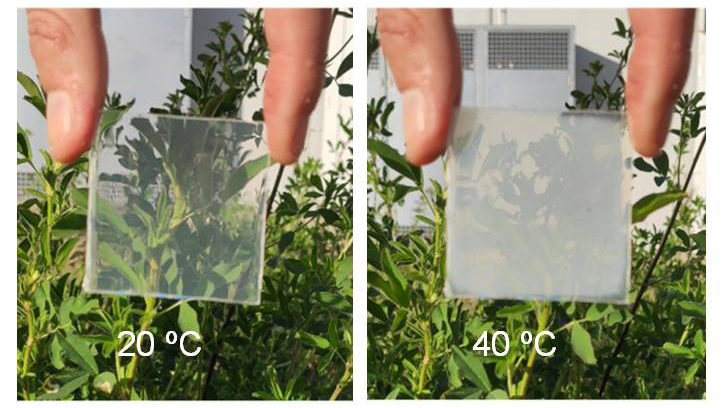A new generation of smart windows for energy saving

The Department of Chemistry of the UAB in collaboration with the ICN2 have developed a new class of smart windows of low cost and facile fabrication based on polymeric coatings loaded with organic wax nanoparticles. Thus, at low ambient temperatures or with little solar radiation, the window is transparent and at high temperatures or on sunny days it turns opaque.
Buildings currently account for about 33% of the global energy use as well as 20% of the energy-related emissions of greenhouse gases. Nearly half of these figures are due to lighting, heating, ventilation and air conditioning systems and, therefore, they are related to light and heat fluxes through windows. Accordingly, one of the principal strategies proposed to improve energy efficiency in buildings is smart windows, which are stimuli-responsive fenestration elements that adapt their sunlight transmission to outdoor conditions – i.e., they exhibit high transparency in cold and cloudy days to favor solar illumination and heating, while they become opaque and block sunlight when warm to reduce air conditioning use. Actually, when applied to apartment buildings, smart windows should allow private energy consumption to decrease by about 5-10%.
Unfortunately, current smart window technologies suffer from several drawbacks that prevent their general use - e.g., high cost, difficult preparation and installation, and low photostability. To overcome these limitations, our research group at the Department of Chemistry in collaboration with Dr. Claudio Roscini and Dr. Daniel Ruiz-Molina from the Catalan Institute for Nanoscience and Nanotechnology (ICN2) has pioneered a novel methodology for the fabrication of smart windows. Our systems are made of polymer films loaded with nanoparticles of common organic waxes that melt at temperatures between 20-60 °C. By wisely selecting the composition and refractive indexes of these elements, the resulting composite materials show a high sunlight transparency at low temperatures when wax nanoparticles are in the solid state; by contrast, when these nanoparticles are heated and melted by solar heat and light or by an external electrical current, our polymer coatings become opaque and exhibit low sunlight transmittance. As a result, when applied to house models, our smart windows warrant large solar illumination and heating on cold days, while allowing for an indoor temperature reduction of up to 6 °C on hot and sunny days.
Transparent-to-opaque transitions achieved in these smart windows upon sunlight illumination and application of external voltages.
When compared to present technologies, our smart windows show an ample range of advantages: facile fabrication from low-cost materials, which should allow reducing their price between 10- to 100-fold relative to current commercial systems; high photostability, flexibility and scalability; fine-tuning of their response to make it suitable for distinct climate areas; and capacity of enabling sunlight transmittance modulation both spontaneously depending on outdoor conditions and under user's control. Consequently, our smart windows could be used massively to enhance energy efficiency in buildings as well as to regulate solar light transmission in other applications (greenhouses, vehicles...).
Department of Chemistry, Faculty of Sciences, Universitat Autònoma de Barcelona
References
Otaegui, J. R., Ruiz-Molina, D., Hernando, J. & Roscini, C. (2023). Multistimuli-responsive smart windows based on paraffin-polymer composites. Chemical Engineering Journal, 463, 142390. https://doi.org/10.1016/j.cej.2023.142390

